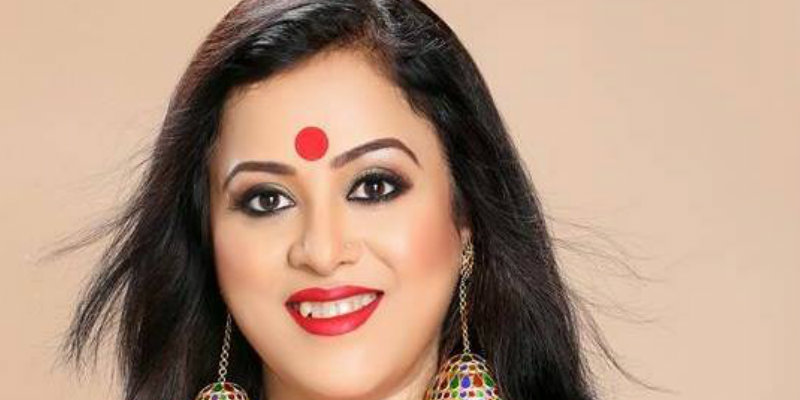Born in the Nagoan district of Assam, Sanjukta did her Bachelors of Engineering from Assam Engineering College in 1995, and joined the Public Works Department (PWD) of the Government of Assam as an Assistant Engineer. She worked at the PWD for ten years.
Since childhood, Sanjukta had a love for the Mekhela Chador, sometimes designing the garment for family members, friends and herself. Since then, the zeal for propagating this piece of pure beauty was instilled in her, especially when people expressed a liking for her design. This eventually led her to resign from her job and start a weaving unit in Guwahati in January 2012 to design Mekhela Chador. Within a year and a half, Sanjukta managed to sell 3,000 units of her designed fabrics.
Sanjukta Dutta creates unique garments by clubbing prints of different places, with the Assamese silk mekhela chador as the base in most cases. In an exclusive interview with Fibre2Fashion, she tells us about her beautiful pieces and her efforts to redress problems of weavers.

Fibre2fashion : Tell us about your collection at Lakme Fashion Week 2017.
Sanjukta Dutta: Lakme Fashion Week 2017 was my debut solo show. I was delighted with the wonderful response. My collection saw a balance of infused traditional Assamese motifs on the graceful mekhela chador. I introduced sarees and lehenga-cholis made from Assamese silk. The vibrancy of the Bodo and Miri communities created a unique canvas through different flower and traditional motifs. My collection reflected a lively ethos.
Fibre2fashion : You usually incorporate traditional designs of different parts of the country to the mekhela chador. What is the inspiration for your latest collection? Which Assamese motifs have you used and what is their significance?
Sanjukta Dutta: I believe that clothing is not just a piece of cloth but an integral part of the wearer’s identity. I love playing with colours and designs. Some of my work draws influence from bandhej, leheria, ari and digital prints. I experiment with these textures and Assamese traditions, blended with modern accents.
Fibre2fashion : What has the response been for this collection?
Sanjukta Dutta: The response to my recent collection showcased at Lakme Fashion Week 2017 was excellent, especially for the mekhela worn by Preity Zinta.
Fibre2fashion : How do you market your creations?
Sanjukta Dutta: My Guwahati store displays my latest collection. However, marketing on social media has helped me reach out to the maximum customers. On an average, approximately 500 sets of mekhela chador are sold every month. Prices vary from Rs 10,000 to Rs 80,000.
Fibre2fashion : How is weaving a mekhela chador different from weaving other traditional Indian outfits?
Sanjukta Dutta: My collection offers a wide range of silk mekhela chador with different varieties of coloured silk thread. Every mekhela chador is unique, customised and hand-crafted by a select bunch of specialised mekhela chador artisans whose craft almost went extinct. The materials are locally produced from a particular type of silkworm found only in one village in Assam. Each piece goes through a rigorous 45-day production cycle before it can tell the story that the beautiful woman draping it, wants it to.
Fibre2fashion : What is the market for mekhela chador outside Assam?
Sanjukta Dutta: Earlier, wherever I went, people were aware of silk sarees from different regions of the country, but very few knew about the traditional Assamese split saree made from Assamese silk. The scenario has changed. People are getting to know about the mekhela chador. They appreciate the fact that apart from being pretty, it is easier to wear than a saree. About 40 per cent of my clients are non-Assamese and from the younger generation who are interested in wearing sarees but find it a little difficult to drape one. I also design pre-pleated sets so the wearer only uses the hooks to put the mekhela in place.
Fibre2fashion : Where do you source your fabric?
Sanjukta Dutta: All the material is procured from Assam. I only design in silk. I work with pat or mulberry silk, muga, a beautiful golden silk indigenous to Assam and tussar, which has a rich beige-gold colour and lovely texture. Metal yarn, used for motifs and borders, gives a rich look.
Fibre2fashion : What is the size of your weaving unit? How many weavers do you work with?
Sanjukta Dutta: In 2012, I opened a weaving unit with just three handlooms. I always wanted to customise bridal outfits. I sold 3,000 units of my products within a year-and-a-half in Sohum, Guwahati.
Fibre2fashion : What are the issues that your weavers face? As a designer, what are you doing to redress their problems?
Sanjukta Dutta: In 2012, I made a humble start with three looms. Today, I work with more than 100. The journey has not been smooth. As in other parts of the country and in other art forms, the weavers, who are the true artisans, also began to fall prey to the machinations of demand and supply. Cost advantage of China drew a large portion of the muga industry out of Assam. Better financial opportunities in other areas slowly drew artisans away. So, one factor I had to battle with while trying to revive this industry was to get these artisans back. Today, I support over a hundred families of artisans, covering aspects like education, medical costs, lodging and boarding, besides competitive salaries. The benefits are showing. Even after giving them these facilities, we are making healthy profits which we re-invest to get more artisans back.







